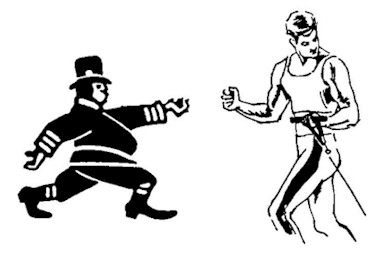LOSE FAT AND GAIN MUSCLE

Last May NOHA speaker, Michael Colgan, PhD, presented himself as grossly obese, explained to us the many disadvantages of being overly fat, and told us how to change permanently. Calorie-counting diets that leave us hungry are counterproductive. Most people, who follow these diets, quickly regain all (if not more) of the fat they lost as soon as they stop the diet. Dr. Colgan reminded us that over the millennia, when human beings were hunters, we needed to be prepared for times of scarcity. Whenever we cut calories and feel hunger, certain enzymes are activated that quickly convert food to storage fat and thus prepare us to survive in times of scarcity. In order actually to convert body fat into muscle, we must avoid triggering this survival mechanism. Consequently, we have to be patient and proceed slowly. He told us to "Sneak the fat off."
After Dr. Colgan had told us about helpful nutrients for gradually converting fat to muscle in our bodies and while telling us about resistance exercise, he suddenly discarded the pillow and the other padding from his costume, which had made him into a waddling obese person, and appeared before us as a superbly fit and muscular fifty-year-old man.
Certain foods are helpful and certain others should be avoided. Calories from saturated fat are especially easily converted into fat cells. In his excellent book on sports nutrition,1 Dr. Colgan explains that many toxins are concentrated in the fat of most meats sold in America today. He vividly pictures the contrast between this fatty meat and the lean, organic meat on which our ancestors thrived and which is now a rare luxury.
Insulin helps with the building of digested proteins into our muscles. Chromium is essential for normal insulin metabolism, including this muscle-building process. Therefore, Dr. Colgan recommends supplementing with chromium picolinate.
Avoid sugars, except "during and immediately after intense exercise, [because] every time you eat simple sugars, especially sugared drinks, blood sugar rises precipitously and causes an insulin burst. The liver then balances the insulin see-saw by turning the excess into triglycerides (fats), which are promptly deposited as body fat."2 Eating a high fiber diet is helpful in stabilizing insulin production because it slows the absorption of both fats and sugars.
Insulin efficiency is increased by the omega-3 fatty acids, particularly by ecosapentaenoic acid (EPA) and docosahexaenoic acid (DHA), both of which are found in certain fish oils. (See NOHA NEWS, Fall 1991, "Stalking the Essential Fatty Acids," p. 6.)
L-carnitine, an amino acid that we can make in our bodies, is essential for burning fat inside our muscle cells. Dr. Colgan often recommends supplementation.
Among Dr. Colgan's main points was the fact that it is NOT a person's total weight that matters but rather what percentage of the weight is body fat versus muscle. Because muscle weighs more than fat, a slim, fit person often weighs more than a fat, unfit person of the same height. One of Dr. Colgan's most vivid examples was of thin, young, female models with 30 per cent body fat, who barely had enough strength to get up and walk around!
In order to lose unwanted fat and put on muscle, the most helpful procedure of all is to engage in resistance exercise; in other words, exercise using weights or the many machines that are now carefully designed to help us build muscle. We can even just use the weight of our own bodies, for example, by doing pushups, pullups, or carefully curling into bent-knee situps. Dr. Colgan warned us that untrained people should be very careful using weights on our ankles or in our hands because, if we allow the weights to swing in an uncontrolled manner or into the wrong position, we could easily injure our muscles rather than build them up. When asked what time of day is best for exercising he recommended the morning because then we increase our rate of metabolism (energy-production) and the rate will remain higher than it would have been even when we are just doing regular desk work later in the day. When asked about aerobic exercise he said that it is excellent for the heart. However, aerobic exercise itself breaks down muscle so that, for the most muscle-building and fat-burning, we need to concentrate on doing weight-bearing exercises, as well as consuming the proper nutrients, and getting adequate sleep. Essentially, in order to gain strength, a muscle must be stressed and then recover. Therefore, the extra work for the heart in aerobic exercise is a necessary part of making the heart muscle stronger; just as resistance exercises are essential for building up the strength of our bodily muscles.
After Dr. Colgan had told us about helpful nutrients for gradually converting fat to muscle in our bodies and while telling us about resistance exercise, he suddenly discarded the pillow and the other padding from his costume, which had made him into a waddling obese person, and appeared before us as a superbly fit and muscular fifty-year-old man.
_____________
1Colgan, Michael, Optimum Sports Nutrition: Your Competitive
Edge, A Complete Nutritional Guide For Optimizing Athletic Performance,
Advanced Research Press, New York, 1993.
2Ibid., p. 137.
Article from NOHA NEWS, Vol. XVIII, No. 3, Summer 1993, pages 3-4.